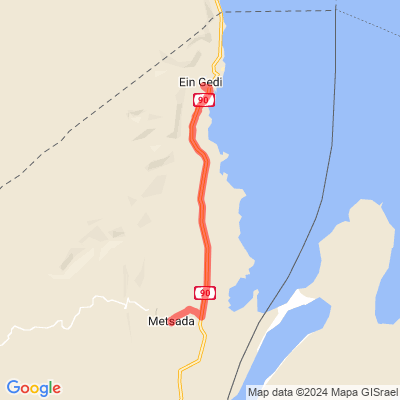
Ein Gedi Camp Lodge to Masada tourist center
Motorcyclist Map

Route Suggested By: Helio Diamant - https://diamant.org.il/blog
View In Google Maps: https://maps.app.goo.gl/FSCPTeFDS1zuF67F7
GPX Download: https://drive.google.com/file/d/1t4LkG2OiniGV1bTwZaA1xBRU5tYMuvLh/view?usp=sharing
Description: Another 19 Km South of the Ein Gedi Camp Lodge, you will find Masada, the historical site. For those who did not live at the 1970s and haven't seen the movie, Masada was the site of the last battle between the zealots Jews and the Romans when they conquered the holy land. The site was first fortified by Hasmonean ruler Alexander Jannaeus in the first century BCE. However, so far, no Hasmonean-period building remains could be identified during archaeological excavations. Herod the Great captured it in the power struggle that followed the death of his father Antipater in 43 BCE. The site is completely built upon the cliff in the middle of the desert and had place to keep and feed some thousands of people. Despite the placement in the desert, an intelligently built system of cisterns could accumulate the water of the rains and rivers in the winter to provide drinking water for all the year, to all the population. In the last Jewish-Roman war, the governor of Judea, Lucius Flavius Silva, determined and commanded the siege of Masada, to conquer the place and take the zealots led by Elazar Ben Yair imprisoned. The siege took place between 73 and 74 CE. After understanding that they wouldn't be able to conquer the place through the existing path up the mountain (nowadays known as the Snake Path), they decided to build a straight path at the back of the mountain for fast access (nowadays known as the Roman Path). Documentation written by Josephus at the time tells that the romans used for the works Jewish captured slaves from Jerusalem, and that prevented the zealots from killing them and resisting the building of the path. When they arrived at the top of the mountain, the romans found only a giant graveyard, since Elazar Ben Yair managed to convince the people that, rather than falling into slavery, it was better that every father killed his family and then all the fathers would kill one another until the last one would be left alone and kill himself. Today, Masada is a busy tourism point and archaeological excavations center. As a tourist, you will be able to see the two castles built by Herod the Great, the cistern system, the bath house, housings of the people, storerooms, and many other constructions that were recovered. That and the stunning view of all the Dead Sea area. Among the Israeli motorcyclists, for many years there was a tradition of travelling to Masada in the night of the Jewish New Year (in September) for seeing there the first sunrise of the year. But the thing became too big to manage, with dozens of thousands of participants, so there is not an organized initiative anymore. Nowadays, riders that want to see the first sunrise divide themselves between Masada and Mt. Bental at the Golan Heights. There are three ways to reach the top of Masada, marked in Blue and Green in the map: The rapid way (Blue): Reaching the visitor center and using the cable car. The explorer way (Blue): Reaching the visitor center and continuing by foot through the Snake Path The Roman way (Green): For this way, you will need to travel on the motorcycle on road 90 to the South until you pass Ein Bokek and Neve Zohar, than take road 31 up to the city of Arad (it is a great road for riding, full of twists), and from Arad go into a small road that takes you to the back of the mountain. There you can go up through the Roman Path by foot. It is a fast way up (around 20 minutes), but with an extremely hard inclination. This is usually used by youth going up before sunrise to see the sunrise from above.
Admin Country: Israel